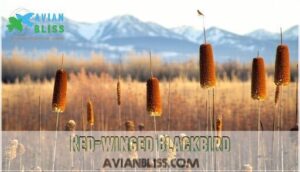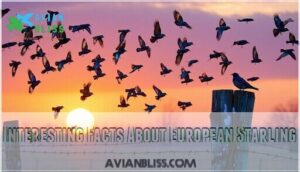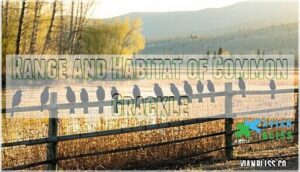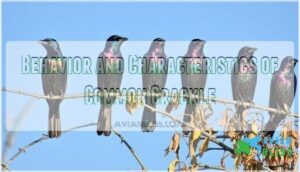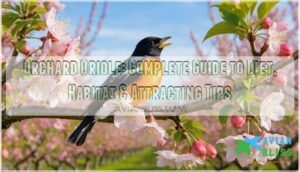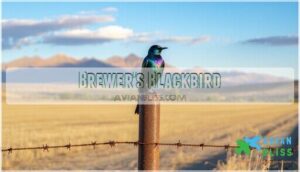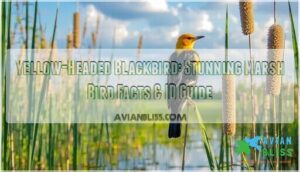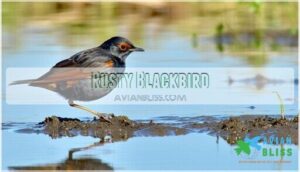This site is supported by our readers. We may earn a commission, at no cost to you, if you purchase through links.
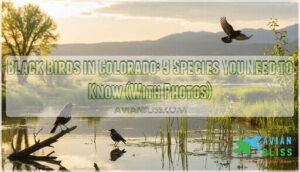
Red-winged blackbirds flash their scarlet shoulder patches in wetlands, while European starlings raid your feeders with their iridescent plumage.
Brown-headed cowbirds follow cattle like feathered shadows, and common grackles strut with that unmistakable glossy sheen.
Don’t overlook the Baltimore and orchard orioles – they’re not entirely black but sport striking dark markings.
Brewer’s blackbirds prefer open spaces, yellow-headed blackbirds dominate marshy areas, and rusty blackbirds are becoming increasingly rare.
Each species has fascinating behaviors and preferred habitats that reveal Colorado’s rich avian diversity.
Table Of Contents
- Key Takeaways
- Red-winged Blackbird
- European Starling
- Brown-headed Cowbird
- Common Grackle
- Baltimore Oriole
- Orchard Oriole
- Brewer’s Blackbird
- Yellow-headed Blackbird
- Rusty Blackbird
- Frequently Asked Questions (FAQs)
- What is the state bird of Colorado?
- What types of birds can be seen in Colorado during the winter?
- What types of birds can be seen in Colorado during the summer?
- Are there any endangered bird species in Colorado?
- What is the best time of year for birdwatching in Colorado?
- What habitats can be found in Colorado that is good for birdwatching?
- What are those common black birds called?
- What are the black birds all over my yard?
- What black birds migrate through Colorado seasonally?
- How do black birds survive Colorado winters?
- Conclusion
Key Takeaways
- You’ll find nine distinct black bird species across Colorado’s diverse habitats, from wetlands to urban areas, each with unique identifying features like the red-winged blackbird’s scarlet shoulder patches and the common grackle’s iridescent sheen.
- These birds occupy specific ecological niches – red-winged blackbirds dominate marshes, brown-headed cowbirds follow cattle in grasslands, European starlings thrive in cities, and yellow-headed blackbirds prefer deeper wetlands than their red-winged cousins.
- You can attract several species to your backyard by providing appropriate food sources like sugar water for orioles, maintaining bird baths, and planting native fruiting trees – though some species, like the rusty blackbird, remain extremely rare due to significant population declines.
- Understanding their behaviors helps with identification – watch for territorial displays, flocking patterns, and unique characteristics like the brown-headed cowbird’s brood parasitism (laying eggs in other birds’ nests) and the European starling’s remarkable mimicry abilities.
Red-winged Blackbird
You’ll spot Red-winged Blackbirds throughout Colorado’s marshes and wetlands, where males perch prominently on cattails flashing their brilliant red shoulder patches like tiny stop signs.
These territorial birds are Colorado’s most common blackbird species, with males arriving first each spring to claim prime real estate before the streaky brown females show up to build their nests, exhibiting a notable display of territorial behavior.
Male blackbirds stake out the best wetland spots before females arrive—nature’s ultimate real estate competition.
Range and Habitat of Red-winged Blackbird
You’ll spot these distinctive black birds, Colorado residents, throughout wetland habitats across the state.
Redwinged Blackbirds thrive in marsh ecosystems, establishing breeding grounds in cattail-dominated areas.
Their migration patterns bring them to Colorado’s marshes each spring, transforming black bird habitat into bustling songbird communities.
These Colorado bird species prefer nesting sites near shallow water, where emergent vegetation provides perfect cover.
Identification and Behavior of Red-winged Blackbird
When you observe a red-winged blackbird, you’ll notice its stocky build and distinctive shoulder patches that males flash during territorial displays.
These black birds Colorado residents know well exhibit aggressive nesting behavior, fiercely defending their redwing habitat in marshes.
Listen for their musical "conk-la-ree" call—it’s like nature’s property alarm system.
Males arrive first during blackbird migration, claiming prime real estate before females.
Their feather patterns make black bird identification easier: males sport brilliant red and yellow shoulder badges, while females wear streaky brown camouflage.
Watch for their characteristic tail-flaring posture on cattails—classic Colorado bird species bird behavior that signals "this territory’s taken.
Unique Characteristics of Red-winged Blackbird
Red-winged blackbirds stand out among Colorado bird species with their flashy shoulder patches and territorial nature.
Males flaunt bright red plumage bordered by yellow on their black body, while their conical bill helps crack seeds efficiently.
- Aggressive behavior peaks during breeding season when males fiercely defend marsh territories
- Shoulder patches serve as visual warnings to rivals and attraction signals for mates
- Black body contrasts dramatically with crimson wing markings in sunlight
- Red plumage appears most vibrant when males spread wings during territorial displays
Their distinctive "conk-la-ree" call echoes across wetlands, making black bird identification easier for Colorado birdwatchers.
European Starling
You’ll spot European Starlings year-round across Colorado, where they’ve mastered the art of urban living better than most locals.
These chunky, medium-sized birds strut through parking lots and perch on power lines with the confidence of someone who knows they own the place.
Range and Habitat of European Starling
European Starlings have conquered Colorado’s cities and towns since their 1890 introduction from European ecosystems.
These adaptable black birds thrive in urban habitats where native cavity-nesters once ruled.
You’ll find them everywhere—parking lots, parks, and residential areas across Colorado.
| Habitat Type | Population Density | Impact on Natives |
|---|---|---|
| Urban Centers | Very High | Severe Competition |
| Suburban Areas | High | Moderate Displacement |
| Rural Farmland | Moderate | Limited Conflict |
| Natural Forests | Low | Minimal Presence |
Their remarkable bird adaptation to human environments makes them Colorado’s most successful invasive species.
Starling migration patterns bring massive winter flocks that dominate feeders and roost sites, pushing out native bird species throughout the state.
The presence of European Starlings affects local bird feeder sales and ecosystem balance.
Identification and Behavior of European Starling
You’ll spot these stocky black birds with their distinctive yellow beaks during breeding season, transforming to dark bills in winter. European Starlings showcase iridescent green and purple plumage that catches sunlight beautifully.
Their Urban Adaptation skills make them masters of Bird Flocking behavior.
Key identification features include:
- Medium build with short tails and pointed wings
- Glossy black plumage with seasonal color variations
- White-spotted winter feathers that disappear in spring
These Colorado birds demonstrate remarkable Bird Behavior through their Starling Diet flexibility, consuming everything from insects to fruits. Their aggressive cavity-nesting habits and large flocking patterns make European Starling identification straightforward for bird enthusiasts practicing black birds recognition.
Interesting Facts About European Starling
Beyond their remarkable appearance, European Starlings possess extraordinary abilities that’ll surprise you.
These black birds demonstrate impressive Bird Intelligence, mimicking over 20 different sounds including car alarms and human speech. Their Urban Adaptation skills are unmatched among bird species in Colorado.
Here are fascinating European Starling facts:
- Feather Colors shift seasonally from glossy black with iridescent purple-green hues to spotted winter plumage
- Flocking Behavior creates mesmerizing murmurations with thousands of birds moving as one unit
- Starling Migration patterns vary, with some populations staying year-round while others travel hundreds of miles
- Bird Intelligence rivals corvids, using tools and solving complex problems in laboratory settings
- Urban Adaptation allows them to thrive in cities, nesting in traffic lights and building crevices
Their success in Colorado birdwatching locations stems from remarkable adaptability and social coordination.
Brown-headed Cowbird
You’ll find Brown-headed Cowbirds throughout Colorado’s grasslands and residential areas, where they’ve adapted surprisingly well to human development.
These birds are famous for their unusual reproductive strategy – they’re brood parasites who lay their eggs in other birds’ nests instead of raising their own young, which is a key aspect of their behavior as brood parasites.
Range and Habitat of Brown-headed Cowbird
You’ll find Brown-headed Cowbirds throughout Colorado’s diverse landscapes, from prairie grasslands to suburban backyards.
These adaptable bird species in Colorado have capitalized on Grassland Expansion and thrived in Residential Habitats across North America.
| Habitat Type | Primary Features | Cowbird Activity |
|---|---|---|
| Open Grasslands | Native prairies, agricultural fields | Foraging, host-seeking |
| Residential Areas | Parks, golf courses, suburbs | Year-round presence |
| Woodland Edges | Forest margins, riparian zones | Breeding territory overlap |
Cowbird Migration patterns bring these black birds in Colorado to lower elevations during winter months.
While Habitat Loss affects many species, Brownheaded Cowbird populations remain stable due to their flexibility in selecting Colorado bird habitats and adapting their Breeding Patterns to available bird habitats.
Reproductive Behavior of Brown-headed Cowbird
Brown-headed Cowbirds have mastered one of nature’s most controversial survival strategies through brood parasitism.
Nature’s ultimate freeloaders: dumping eggs in other birds’ nests while the real parents do all the work.
These clever Colorado bird species don’t build their own nests—instead, females scout for active nests belonging to other birds.
The cowbird mating process involves males performing courtship displays while females focus on locating suitable host nests.
During breeding season, female brownheaded cowbirds employ sophisticated nesting strategies.
They remove one host egg, then quickly deposit their own egg in under sixty seconds.
This rapid egg laying technique guarantees successful parasitism across over 220 different host species.
Here’s what makes their breeding habits so remarkable:
- Your backyard songbirds unknowingly become foster parents
- Cowbird chicks often hatch first, dominating smaller nestmates
- Host parents exhaust themselves feeding oversized cowbird babies
- Some bird species have evolved defenses against this deception
- This bird behavior affects entire Colorado bird communities
Ecological Impact of Brown-headed Cowbird
Nature’s freeloaders cause serious trouble for Colorado’s bird species.
Brown-headed Cowbirds practice brood parasitism, dumping eggs in other nests and forcing hosts to raise their young.
This cowbird behavior devastates nesting strategies of warblers, sparrows, and other black birds.
Their ecological consequences include reduced host reproduction and altered avian interactions, which is a result of the brood parasites and their actions.
Colorado bird conservation efforts now target these brood parasites through trapping programs.
Common Grackle
You’ll recognize Common Grackles by their impressive 11-13 inch length and striking iridescent plumage that shimmers blue, green, or purple in sunlight.
These intelligent birds gather in large flocks during winter months and display fascinating social behaviors, including their ability to crack open acorns by holding them with their feet, showcasing their intelligent nature.
Range and Habitat of Common Grackle
Common Grackles thrive across diverse habitats throughout Colorado, from urban parks to wetland edges.
These adaptable black birds favor open woodlands, agricultural fields, and suburban areas where they can easily forage.
You’ll spot them strutting across lawns, hunting insects in freshly plowed fields, and congregating near water sources.
During Grackle Migration seasons, large flocks gather in marshes and grasslands.
However, Habitat Loss from Urban Expansion threatens their traditional nesting sites.
Wetland Ecology restoration and Grassland Conservation efforts help maintain suitable habitat.
For Colorado Birding enthusiasts, Common Grackles represent one of the most visible Black Birds in Colorado Wildlife, making them excellent subjects for studying Bird Species Colorado.
The conservation status of Common Grackles is influenced by their ecological role in maintaining ecosystem balance.
Behavior and Characteristics of Common Grackle
You’ll spot these black birds displaying their stunning iridescent feathers that shimmer purple, blue, and green in sunlight.
Common Grackle flocks demonstrate fascinating social behavior through coordinated movements and communal roosting.
Their foraging habits reveal impressive adaptability as they:
- Follow farm equipment to catch disturbed insects
- Scavenge human food waste opportunistically
- Adjust their grackle diet seasonally from insects to seeds
During migration patterns, thousands gather in spectacular roosts.
These intelligent colorado birding favorites showcase complex black bird behavior through vocal communication and cooperative mobbing against predators, making them essential bird species colorado residents.
Baltimore Oriole
You’ll spot Baltimore Orioles in Colorado’s riparian areas and suburban parks, where they hunt insects and feast on nectar from flowering trees.
These vibrant orange and black birds prefer tall deciduous trees near water sources for nesting and foraging throughout their brief summer visits, and they are known to thrive in areas with an abundance of nectar from flowering trees.
Range and Habitat of Baltimore Oriole
Why do Baltimore Orioles capture birdwatchers’ hearts in Colorado? These vibrant bird species in Colorado breed primarily in eastern North America’s open woodlands and riverbanks, with their range extending west to the Great Plains.
Their Migration Patterns bring them through Colorado during spring and fall journeys to Central American wintering grounds.
Habitat Loss threatens their preferred environments, but you’ll find them in:
- Nesting Sites along wooded streams and parks with mature trees
- Food Sources in orchards and gardens with abundant insects and nectar
- Bird habitat preferences in Colorado include riparian areas and suburban landscapes.
Conservation Efforts help maintain these black birds in Colorado populations. This Colorado bird species guide species favors areas where elm, maple, and cottonwood trees provide ideal nesting conditions for their distinctive hanging nests.
Feeding Habits and Diet of Baltimore Oriole
You’ll spot Baltimore Orioles working through tree canopies like tiny acrobats, targeting ripe fruit and sweet nectar sources.
Their bird diets also feature insect catching for protein and occasional seed eating.
Pollen gathering happens naturally as they probe flowers. The Baltimore Oriole’s feeding style combines athletic precision with a sweet tooth that’d make any kid jealous.
Understanding their diet requires knowledge of Oriole Food sources and preferences, including fruit consumption and nectar gathering at various plants like trumpet vines and honeysuckle.
Attracting Baltimore Orioles to Your Backyard
You’ll attract Baltimore Orioles to your backyard by setting up oriole feeders filled with sugar water or grape jelly.
Place bird baths nearby for drinking and bathing. Plant native flowering plants and fruit trees like cherry or mulberry to provide natural food sources.
Create a welcoming backyard habitat with tall trees for nesting sites. These black birds in Colorado arrive in spring, making early preparation essential.
Bird watching in Colorado becomes more rewarding when attracting orioles to your backyard. Avoid pesticides to preserve insects they need.
Fresh orange halves on feeders work like magic for these vibrant Colorado bird species. To enhance your yard’s attractiveness, consider implementing a blue jay friendly environment that also benefits other bird species.
Orchard Oriole
You’ll spot Orchard Orioles in Colorado mainly during winter months, making them a rare but exciting find for bird watchers.
These smaller orioles prefer open woodlands and park edges, with males displaying distinctive dark orange plumage and black heads that set them apart from their Baltimore cousins.
Range and Habitat of Orchard Oriole
You’ll find Orchard Orioles across a surprisingly broad range, from the Great Plains eastward to the Atlantic Coast and south into Mexico.
These black birds in Colorado prefer open woodlands, orchards, and riparian areas with scattered trees rather than dense forests.
During bird migration, they travel remarkable distances to reach their wintering sites in Central America and northern South America.
Here are five key habitat preferences for Orchard Orioles:
- River valleys with cottonwoods and willows
- Farmland edges near water sources
- Parks and orchards with mature shade trees
- Grasslands dotted with isolated tree groves
- Suburban areas with native fruiting plants
Colorado habitats that support these Colorado bird species include lower elevation riparian zones where oriole nesting occurs in late spring.
Their bird habitat preferences focus on areas offering both insects and fruit, making bird range maps show concentrated populations near water corridors throughout their breeding territory.
Identification and Behavior of Orchard Oriole
You’ll recognize male Orchard Orioles by their distinctive dark orange plumage and black head—a striking contrast among Colorado bird species.
These skilled insect hunters whistle melodic songs while foraging at forest edges, displaying unique bird behavior patterns. During Bird Migration season, they form social flocks in open woodlands near water sources.
Their Nesting Habits include building hanging pendant nests, which males defend aggressively. The Oriole Diet consists primarily of insects and fruit, making them valuable pest controllers.
Their Plumage Patterns help distinguish them from other black birds in Colorado during bird identification efforts.
Brewer’s Blackbird
You’ll find Brewer’s Blackbird throughout Colorado’s open areas, from agricultural fields to urban parking lots where they forage for insects and seeds.
These adaptable birds display striking iridescent plumage that shifts between purple and green hues in sunlight, making them easier to identify than their plain brown mates.
Range and Habitat of Brewer’s Blackbird
Brewer’s blackbirds roam vast territories across western North America, making them one of Colorado’s most adaptable black bird species.
These resilient birds thrive in diverse environments where urban roosting meets natural Colorado wetlands.
- Open country habitats – Agricultural fields, meadows, and grasslands provide ideal foraging grounds for Brewers blackbird populations
- Wetland environments – Colorado wetlands and marshes offer essential nesting sites and abundant insect prey
- Urban adaptations – City parks, parking lots, and residential areas support growing populations through urban roosting
- Seasonal movements – Brewers migration patterns shift between breeding territories and wintering grounds, supporting bird conservation efforts
Their blackbird habitat preferences demonstrate remarkable flexibility, from remote wilderness to bustling neighborhoods throughout Colorado bird species territories.
Behavior and Characteristics of Brewer’s Blackbird
You’ll spot these social Colorado bird species gathering in mixed flocks during winter, their yellow eyes gleaming as they forage together.
Male Brewer’s blackbirds showcase iridescent purple-blue heads and bronze-green bodies, while females display subtle brown tones.
Their flocking behavior creates impressive aerial displays during blackbird migration periods.
Watch for their distinctive feather patterns that shimmer in sunlight.
These adaptable black birds in Colorado exhibit varied nesting habits, from ground-level shrubs to tree cavities.
Their diet includes insects, seeds, and berries, making them valuable ecosystem contributors across diverse habitats.
The birds’ ability to thrive in various breeding habitats is a key factor in their successful colonization of different environments.
Yellow-headed Blackbird
You’ll spot yellow-headed blackbirds in Colorado’s marshes and wetlands during breeding season, where their bright golden heads make them impossible to miss among the cattails.
These stocky birds prefer deeper water than red-winged blackbirds and produce a harsh, raspy call that sounds like a rusty gate hinge.
Range and Habitat of Yellow-headed Blackbird
During spring migration, Yellow-headed Blackbirds arrive at Colorado’s premier wetland habitats, establishing territories in marshy areas where shallow water meets dense vegetation.
These distinctive black birds in Colorado prefer specific breeding grounds that offer ideal nesting sites and abundant foraging areas.
- Wetland Habitats: Marshes, wet meadows, and cattail-dominated areas across Colorado
- Breeding Grounds: Shallow waters with emergent vegetation for secure nest placement
- Migration Patterns: Arrive from wintering grounds in southwestern United States and Mexico
- Foraging Areas: Open water edges where aquatic insects and seeds are readily available
Identification and Behavior of Yellow-headed Blackbird
Yellow-headed Blackbirds stand out like bright beacons in Colorado’s marshlands with their golden heads and white wing patches.
These black birds in Colorado show distinct habitat selection, preferring deeper wetlands than their red-winged cousins. Males employ aggressive foraging strategies, defending prime cattail territories through wing-drooping displays and raspy calls.
Their social interactions involve complex nesting patterns where females weave cup-shaped homes among dense vegetation. During black birds migration, yellowheaded blackbirds follow established migration routes to southern wintering grounds, making Colorado bird species identification easier during breeding season when their territorial behaviors peak.
Understanding local bird guide resources is essential for recognizing these species and their habitats.
Rusty Blackbird
You’ll rarely spot a Rusty Blackbird in Colorado since they prefer remote, marshy breeding areas far from human activity.
This species faces serious conservation challenges, with dramatic population declines earning it a spot on the IUCN Red List.
Range and Habitat of Rusty Blackbird
Finding Rusty Blackbird populations in Colorado requires understanding their specialized habitat preferences. These black birds in Colorado primarily occupy wetland ecosystems during their limited appearances, favoring marshy areas with dense vegetation.
Their breeding grounds span Canada’s boreal forests and Alaska’s remote wilderness, while Colorado bird species diversity includes them mainly as uncommon migrants.
Bird migration patterns bring Rusty Blackbirds through Colorado’s high-elevation wetlands during spring and fall journeys.
Habitat loss threatens their traditional stopover sites, making conservation efforts critical for protecting remaining wetland habitats that support black bird species migration routes. Understanding the importance of unique bird habitats is vital for developing effective conservation strategies to preserve these ecosystems.
Conservation Concerns for Rusty Blackbird
You’ll witness alarming Population Decline statistics for Rusty Blackbirds—over 85% since the 1960s.
Habitat Loss from wetland drainage devastates their breeding grounds.
Colorado bird conservation groups focus on Wetland Management and Species Protection through restored ecosystems.
Conservation Efforts target pollution reduction and predator control.
Bird conservation efforts require immediate action to prevent this black birds species from disappearing entirely from North America’s boreal forests.
Frequently Asked Questions (FAQs)
What is the state bird of Colorado?
Like a prairie jewel gleaming in sunlight, you’ll discover Colorado’s state bird isn’t a crow or blackbird.
The Lark Bunting, Calamospiza melanocoryus Stejneger, was adopted as the official state bird on April 29,
These migratory sparrows arrive each spring with males sporting jet-black plumage and striking white wing patches.
What types of birds can be seen in Colorado during the winter?
During winter months, you’ll spot European Starlings with their speckled plumage, American Crows braving the cold, and Brown-headed Cowbirds in residential areas.
Turkey Vultures also winter here, soaring above snow-covered landscapes.
What types of birds can be seen in Colorado during the summer?
While you’d expect fewer birds during Colorado’s blazing summer months, you’ll actually spot more black bird diversity.
Red-winged blackbirds dominate marshlands, brown-headed cowbirds roam grasslands, and European starlings thrive everywhere, making summer prime blackbird-watching season.
Are there any endangered bird species in Colorado?
You’ll find several endangered bird species in Colorado.
The whooping crane is the tallest bird in North America, while the Gunnison sage-grouse is found almost exclusively in Colorado, and 90 percent of its native habitat has vanished.
Colorado has many wildlife species on its threatened and endangered list, including several species each of amphibians, birds, fish, mammals, reptiles, and mollusks.
The state’s conservation efforts focus on protecting rare animal species to prevent further population decline, which is a critical aspect of preserving native habitat.
What is the best time of year for birdwatching in Colorado?
Spring through fall offers Colorado’s peak birdwatching seasons.
You’ll spot migrating species during April-May and August-September periods.
Early morning hours provide ideal viewing when birds are most active and vocal before daily temperatures rise.
What habitats can be found in Colorado that is good for birdwatching?
Colorado’s diverse ecosystems support over 26% of America’s 538 million blackbirds and starlings. You’ll find excellent birdwatching in wetlands, grasslands, and riparian corridors where these species thrive year-round.
What are those common black birds called?
You’ll spot several common black birds in Colorado’s diverse habitats.
Red-winged blackbirds display striking red shoulder patches, while European starlings show iridescent plumage.
Brown-headed cowbirds, American crows, and turkey vultures round out the lineup.
What are the black birds all over my yard?
You’re likely seeing Red-winged Blackbirds, European Starlings, or Brown-headed Cowbirds. These adaptable species thrive in residential areas, often gathering in large flocks during feeding times or seasonal migrations.
What black birds migrate through Colorado seasonally?
You’ll see Red-winged Blackbirds, European Starlings, and Brown-headed Cowbirds migrating through Colorado seasonally. Red-winged Blackbirds arrive first in spring to claim territories, while others follow established migration routes.
How do black birds survive Colorado winters?
During winter’s harsh grip, you’ll witness nature’s survival mastery.
Black birds employ fascinating strategies: flocking together for warmth, growing dense feathers, caching food supplies, and seeking shelter in dense vegetation or human structures to endure Colorado’s brutal temperatures, demonstrating nature’s survival skills and fascinating strategies.
Conclusion
Congratulations, you’ve survived another thrilling episode of "Colorado’s Feathered Drama Queens" – where every marsh squabble and backyard invasion makes wildlife documentaries look boring.
These nine black birds in Colorado aren’t just pretty faces; they’re ecosystem engineers shaping Colorado’s landscapes through their feeding, nesting, and territorial behaviors.
From wetland guardians to agricultural followers, each species fills a vital ecological niche.
Next time you spot these dark-winged residents, you’ll appreciate the complex avian community thriving right in your backyard, and understand their role as backyard invasion participants.
- https://cnhp.colostate.edu/download/documents/cwic_docs/CPWSpeciesProfiles/CPWProfiles_BlackRail.pdf
- https://www.colorado.edu/asmagazine/2020/05/13/conflict-and-vigilance-among-red-winged-blackbirds
- https://digitalcommons.unl.edu/icwdmbirdcontrol/49/
- https://www.birdconservancy.org/birds-by-the-numbers/
- https://abcbirds.org/bird/red-winged-blackbird/

